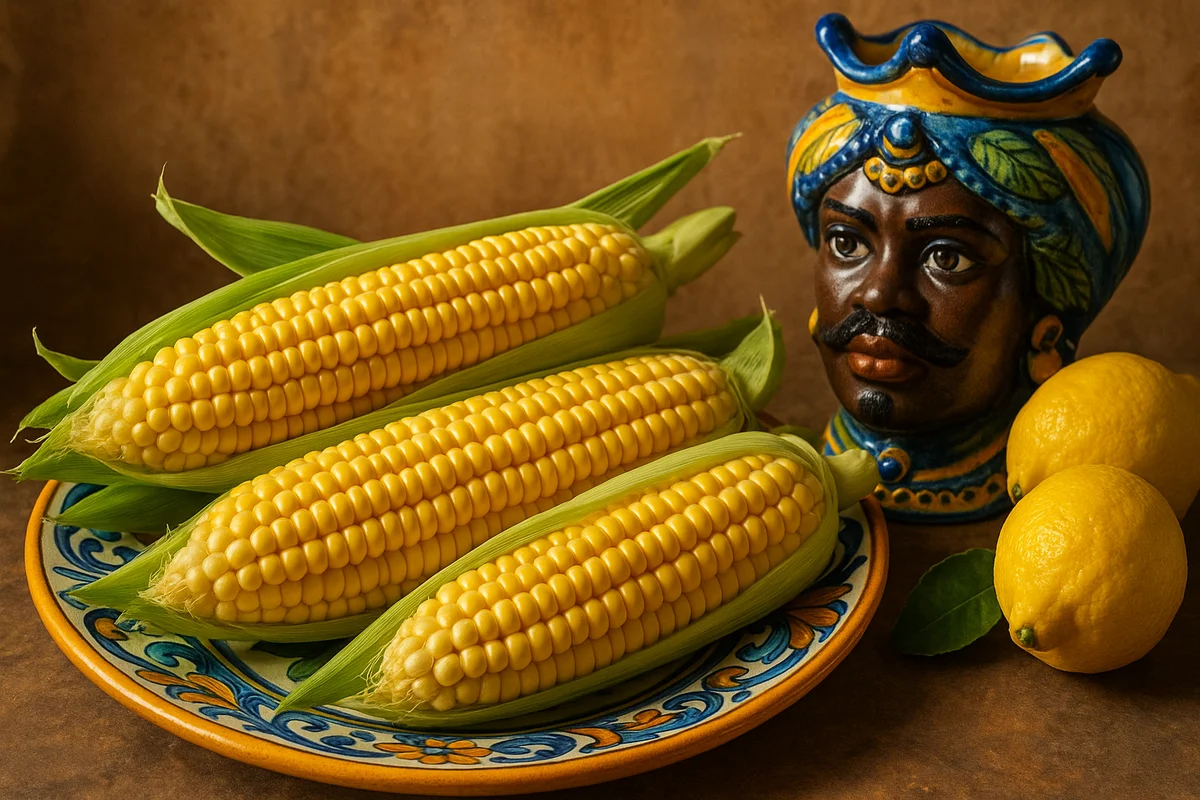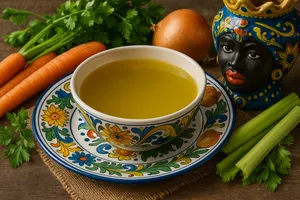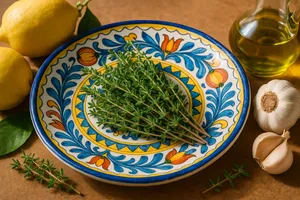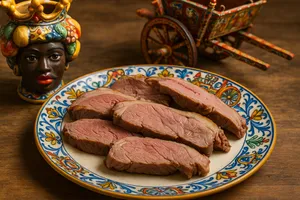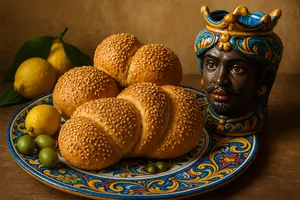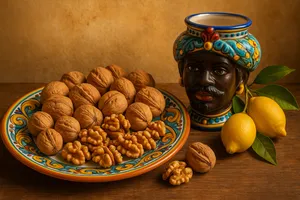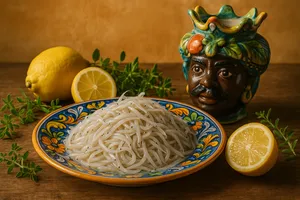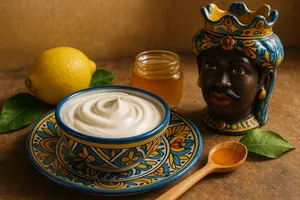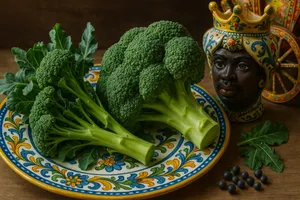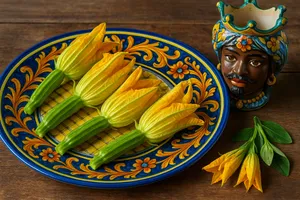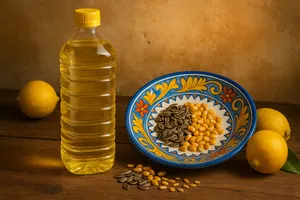Overview
Maize is a cereal native to the Americas and introduced to Sicily following the discovery of the New World in the 16th century. Initially met with suspicion, its distinctive golden kernels gradually became an important food source, especially in the island’s mountain and inland regions where its adaptability to various soils and climates made it suitable for cultivation.
In Sicilian tradition, maize held a special place in the humble, rural cuisine, primarily as the base for polenta—a hearty food that sustained generations of field workers. Cornmeal was also used to prepare bread, flatbreads and rustic sweets. Although not as central to Sicilian cookery as in other Italian regions, maize left significant traces in the culinary traditions of mountain areas and stands as an example of Sicily’s ability to adopt and integrate ingredients from distant cultures.
Characteristics
Maize grows in ears lined with kernels arranged in regular rows. Kernel colour varies depending on the variety and may be yellow (most common), white, red, blue or multicoloured. Kernels are rounded or slightly pointed, hard when dry and soft and juicy when fresh.
The flavour of fresh maize is sweet and delicate, becoming more neutral and gently sweet in dried kernels and flour. Its aroma is characteristic—grassy in fresh maize, milder in flour. Texture ranges widely: crunchy when toasted, tender when boiled, creamy when ground into polenta.
Cornmeal has a golden yellow colour of varying intensity and a granular texture. It may be coarsely, medium or finely ground depending on its intended use.
Varieties
Sweetcorn (table maize)
Varieties with tender, sweet kernels eaten fresh boiled or grilled. They have a high sugar content that decreases rapidly after harvest. These are the ears consumed as a vegetable.
Polenta maize
Varieties with hard, starch-rich kernels used for milling into cornmeal. Sicily once cultivated local varieties adapted to its Mediterranean climate.
Popcorn maize
Varieties with small, very hard kernels that pop when heated. Their tough pericarp traps steam until it bursts.
Ornamental maize
Varieties with multicoloured kernels grown mainly for decoration. Some ancient Sicilian varieties bore assorted colours.
Cultivation in Sicily
In Sicily, maize was grown chiefly in inland and mountain regions where conditions were most favourable. Sowing took place in spring and harvesting in late summer or autumn. Plants could reach 2–3 metres in height.
After harvesting, the ears were left to dry naturally, often hung in airy spaces. Dried kernels were then removed and either taken to the mill for grinding or stored for the following year’s sowing.
Over time, maize cultivation in Sicily declined, replaced by more profitable crops. Today it survives in small areas, often for personal use or niche production.
Culinary uses
In Sicilian cuisine, maize appears in several preparations, especially in the traditions of mountain areas.
Polenta
Cornmeal is cooked in salted water, stirred constantly, until it becomes thick and creamy. In Sicily, polenta was never as widespread as in northern Italy, but in mountain zones it was a vital food, served with meat sauces, mushrooms, vegetables or cheeses.
Cornbread
Cornmeal was mixed with wheat flour to make rustic bread. Pure corn bread was difficult to work due to the absence of gluten, so it was usually combined with other flours.
Flatbreads
Rustic flatbreads made with cornmeal, water, salt and oil, baked in the oven or cooked on stone. They were the everyday bread of mountain communities.
Boiled corn
Fresh sweetcorn is boiled in salted water and eaten directly from the cob, often dressed with butter or oil and salt. A popular summer preparation.
Toasted maize
Dried kernels toasted in a pan until golden create a crunchy snack enjoyed as an afternoon treat or aperitif.
Rustic desserts
Cornmeal appears in some rustic sweets, often combined with other flours to make biscuits or cakes with a distinctive flavour.
Sicilian polenta
Polenta in Sicilian mountain regions had its own characteristics. It was prepared softer than the Venetian version and often enriched with vegetables, legumes or meat sauces. It was rarely cooled and sliced, as in other regions, but eaten warm and spoonable straight from the dish.
Considered humble but nourishing fare, it provided energy for farmers and woodsmen. It was traditionally prepared in large quantities in copper cauldrons, stirred with a long wooden stick (u vastuni).
Flour preparation
Traditionally, dried maize kernels were taken to the mill and ground between stones. The texture varied depending on use: coarse for rustic polenta, fine for sweets.
Freshly ground flour had intense aroma and superior flavour. It needed prompt use because the germ, rich in oils, caused it to become rancid. To ensure longer storage, only small quantities were milled at a time.
Storage
Dried maize kernels keep for 1–2 years in airtight containers stored in cool, dry, dark places. They must be protected from humidity and insects (grain moths may attack them).
Cornmeal keeps for 3–6 months in airtight containers in a cool, dark place. Wholemeal cornmeal (with germ) becomes rancid more quickly. Refrigeration or freezing extends shelf life.
Fresh sweetcorn should be eaten as soon as possible after harvest because sugars convert rapidly into starch. It keeps in the refrigerator for 2–3 days with husks on, stored in a bag. It can be frozen: blanched, cut from the cob and sealed in bags.
Nutritional properties
Maize is an energy-rich cereal: 100 g of cornmeal provides about 360 calories. It is rich in complex carbohydrates (75–80 g per 100 g), mainly starch. Protein content is moderate (7–9 g), fats low (3–4 g), concentrated in the germ.
Maize is gluten-free and therefore suitable for coeliacs. It contains B vitamins—especially B1, B3 and B6—and vitamin E in the germ. It is a good source of minerals such as phosphorus, magnesium and potassium. Carotenoids, responsible for the yellow colour, have antioxidant properties.
Maize is low in bioavailable niacin (vitamin B3) and deficient in certain essential amino acids (lysine and tryptophan). Diets based almost exclusively on maize can lead to pellagra, a niacin deficiency disease that affected poor populations dependent on polenta. Pairing maize with legumes, dairy or meat compensates for these deficits.
Curiosities
Maize arrived in Sicily in the 16th century via the Spaniards, who had brought it from the Americas. Initially regarded with suspicion, it was grown marginally at first. Its spread occurred gradually, particularly in areas where other cereals struggled to grow.
The Sicilian name “granturcu” (“Turkish wheat”) stems from the custom of calling “Turkish” anything from distant or unfamiliar lands, not necessarily from Turkey.
In Sicily’s mountain areas, maize harvesting was a communal event. Families gathered to shell the ears—a long and laborious task brightened by song and conversation. It was an important moment of social life in the farming world.
The husks (the leaves surrounding the cob) were used to weave baskets, mats and to stuff mattresses. Nothing was wasted: even the cobs served as fuel or fire starters.
During the Second World War and the post-war period, when food was scarce, maize polenta became even more important for mountain communities. Many elderly people recall polenta as the daily dish of those difficult years—a symbol of hardship, yet also of survival.

